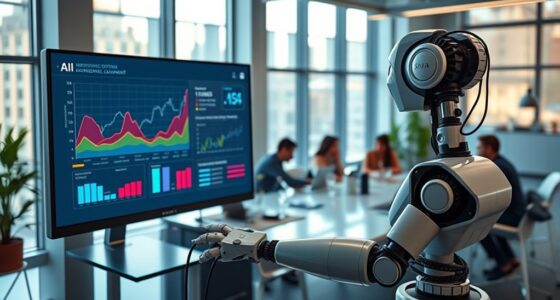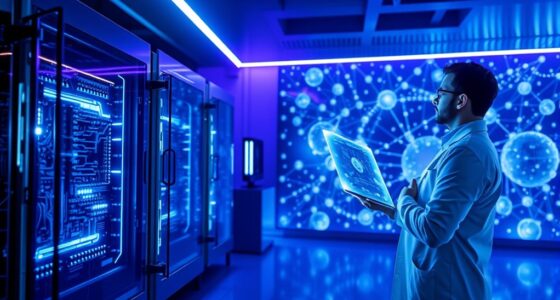AutoML speeds up model development and makes machine learning more accessible, but it often produces opaque models that lack transparency and nuanced understanding. Human ML engineers bring essential judgment, domain knowledge, and ethical considerations that automated systems can’t fully replicate. If you want models that balance accuracy with interpretability and fairness, combining both approaches could be your best strategy. Keep exploring to see how these methods complement each other in practice.
Key Takeaways
- AutoML accelerates model development and handles large datasets efficiently, but may produce less interpretable, opaque models.
- Human ML engineers incorporate domain knowledge, ethical considerations, and nuance, ensuring transparency and fairness.
- AutoML is ideal for rapid prototyping and scaling, while human experts optimize models for specific societal and ethical needs.
- Human oversight helps mitigate biases and ensures models meet regulatory and transparency standards.
- Combining AutoML’s speed with human expertise often yields the most balanced and trustworthy models.

AutoML has revolutionized machine learning by automating tasks like data preprocessing, feature selection, and model tuning, making it easier for non-experts to develop effective models. Instead of spending hours fine-tuning algorithms or trying to understand complex code, you can rely on AutoML tools to quickly generate high-performing models. However, as you leverage these automated systems, questions about model interpretability and ethical considerations come into play. AutoML often produces complex models that may perform well but are difficult to interpret, which can be problematic if you need to explain decisions to stakeholders or comply with regulatory standards. When the model’s inner workings are opaque, it raises concerns about transparency—especially in high-stakes domains like healthcare or finance, where understanding why a model makes a certain prediction is essential.
AutoML simplifies model development but often produces opaque, hard-to-interpret models, raising transparency and ethical concerns in critical domains.
While AutoML can speed up development and optimize performance, it doesn’t always prioritize interpretability. Human ML engineers, on the other hand, bring domain knowledge and experience to the table, allowing them to design models that balance accuracy with clarity. They can tailor models to be more transparent, ensuring stakeholders understand how inputs influence outputs. This interpretability isn’t just about satisfying curiosity; it’s also about fulfilling ethical responsibilities. You want to ensure your models don’t perpetuate biases or make unfair decisions, which is difficult to guarantee with fully automated systems that might optimize for accuracy without considering societal impacts. Human engineers can incorporate ethical considerations into the model design process, selecting features carefully and testing for biases, something that automated processes might overlook if they focus solely on metrics like accuracy or AUC.
Furthermore, human ML engineers are adept at charting the gray areas of model development—deciding when to sacrifice a bit of accuracy for better interpretability or fairness. They can adjust models based on ethical implications, ensuring that the models serve the greater good and align with societal values. AutoML tools, while powerful, often lack this nuanced understanding. They excel at finding the best-performing models within predefined parameters but may not account for ethical considerations unless explicitly programmed to do so. As a result, models built solely through AutoML might be efficient but risk being black boxes that undermine trust. Additionally, the integration of research-backed practices like model validation can significantly improve the reliability of models developed by either approach.
In the end, whether AutoML or human ML engineers build the better model depends on your specific needs. For rapid deployment and optimization, AutoML is attractive. But if your project demands transparency, ethical integrity, and tailored insights, human expertise remains essential. Combining the strengths of both—using AutoML to generate candidate models and human engineers to interpret, refine, and ethically evaluate—might be the most effective approach.
Frequently Asked Questions
Can Automl Replace All Aspects of Human ML Engineering?
You might wonder if AutoML can replace all human ML engineering aspects, but automl limitations still exist. While AutoML automates many tasks, it can’t fully replicate human intuition, creativity, and domain expertise essential for complex problem-solving. Human engineers excel at interpreting nuanced data patterns and making strategic decisions. So, although AutoML boosts efficiency, it can’t entirely replace the nuanced understanding and insight that human ML engineers bring to the table.
How Do Automl Tools Handle Complex, Custom Models?
Ever wonder if automl tools can truly handle complex, custom models? You might find automl limitations challenging when facing complex model challenges, as these tools often struggle with intricate architectures and unique requirements. They excel with standard tasks but may lack the flexibility needed for highly specialized models. While automl speeds up development, for complex and custom projects, human expertise still plays a vital role in achieving optimal results.
What Are the Cost Differences Between Automl and Human ML Development?
When comparing costs, you’ll find that AutoML tools generally have lower initial expenses, making them appealing for tight budgets. They reduce the need for extensive human labor, cutting labor costs considerably. However, if your project requires highly specialized models, the cost of customizing AutoML may rise. Overall, AutoML offers a more budget-friendly approach for rapid development, but for complex needs, investing in human expertise might be more cost-effective in the long run.
How Do Automl Solutions Ensure Model Interpretability?
You want to know how AutoML solutions ensure model interpretability. They often incorporate explanation techniques like feature importance and SHAP values to enhance model transparency. These methods help you understand which features influence predictions, making models more interpretable. AutoML tools aim to balance automation with clarity, so you can trust the insights and verify compliance without sacrificing transparency. This way, you get reliable, understandable models with minimal manual effort.
What Skills Are Essential for Human ML Engineers Today?
You need strong data analysis skills to interpret complex datasets and identify patterns effectively. Programming proficiency is vital for developing custom models, troubleshooting, and optimizing algorithms. Staying updated with the latest ML frameworks and tools helps you adapt to new challenges. Additionally, good communication skills enable you to explain your findings clearly. These skills guarantee you can build robust, accurate models and add value in a rapidly evolving field.
Conclusion
Imagine standing at a crossroads where AutoML and human engineers each hold a lantern, illuminating different paths. AutoML’s bright, steady glow guides you quickly through familiar terrain, but the human touch adds a nuanced, creative spark that paints the landscape in vibrant, unexpected colors. Together, they form a powerful duo, steering the complex terrain of machine learning. Ultimately, your best models emerge when you harness the steady light of AutoML and the inventive spark of human engineers.









